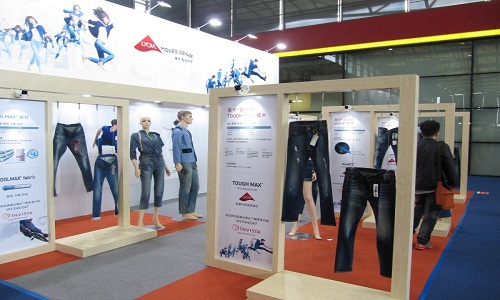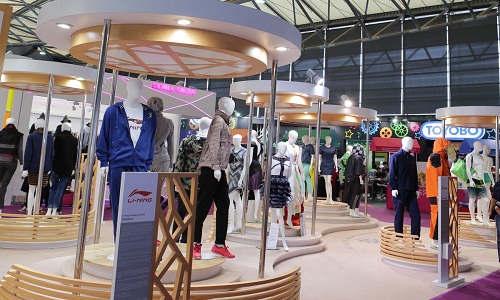FW
Fabric Selection presented its latest collection of knit prints, cotton fabrics, solid wovens, and French terry fabrics. Fabric Selection is an American fabric wholesaler with an elaborate collection of knits, linens, denims, prints, lace, rayon, and others that can be used to make excellent materials in stylish tops, slick swimwear, junior jeans, printed polos, and even sensual lingerie.
The Los Angeles fabric wholesaler has spent countless years providing designers with the best fabrics at exceptional prices. Its success can be attributed not only to its streamlined manufacturing process but to its experienced and dedicated staff who place quality and customer service above all else.
The wholesaler has been providing the Los Angeles fashion district with some of the top quality fabrics that designers and manufacturers utilise to produce cutting-edge designs. Fabric Selection offers a broad array of choices. Each selection is available in a very wide array of colors, styles, and designs. Some of its fabrics are knit fabric, knit prints, solid woven fabrics, woven and rayon prints, poly/rayon blends, solid and printed lace, French terry, jacquard knit, cotton and knit cotton, linen and denim.
www.fabricselection.com/
British textile manufacturer Heathcoat Fabrics has launched a range of flame retardant dress fabrics. Heathcoat Fabrics makes dress nets, tulles and costume fabrics. A typical child’s costume offers no protection to flame and will fully combust in a matter of seconds, while Heathcoat’s equivalent will not burn.
The brand has also developed technology to create fabrics with less than 20 parts per million of formaldehyde. Formaldehyde has been used for decades in washing powders and clothing. It is flammable, emits carbon monoxide when heated, and has been found to be toxic and corrosive. And now it’s possible to create apparel that incorporates such safety precautions.
Heathcoat provides a wide range of own-branded, patented high performance product solutions. It operates a total end-to-end high service with in-house research and development, design, testing and on-site manufacturing facilities that include quality-controlled yarn texturising, warping, weaving and knitting plant and the latest advanced specialist dyeing, textile enhancement treatments and finishing.
Included in the new product offering are the new zero-formaldehyde soft dress net for children's clothes; stiffer flare-free tulles for bridal gown, prom dresses and tutu; dance and fashion dress nets; locknits, textures and technical fabrics, including their own-brand 3D spacetec fabrics in a range of new color and surface combinations.
www.heathcoat.co.uk/
Japan has given a grant to help the cotton industry in Belize. The grant would be used to purchase high clearance tractors and planters. Japan will share its extensive knowledge of processing methods by providing machinery to harvest high quality cotton.
Japan hopes to rejuvenate and expand the production of sea island cotton in Belize. The demand for sea island cotton in Japan is far greater than the world can supply. Because of ideal weather conditions and soil quality, Belize has the potential to become a leading cotton producer in the world. Expanding the industry would be beneficial to the local economy, not just in terms of contributing to the country’s exports, but also because the harvesting of cotton must be done by hand so as not to damage the fibers.
This will create more employment opportunities for local communities. A typical cotton field would need between 150 to 200 cotton pickers and workers can flexibly choose the days they wish to work. Over the past year since the start of the project the harvesters have been primarily women.
Since last year more than 1000 pounds of dried cotton have been received and this year local producers are hoping to produce more than 30,000 pounds of dried cotton worth some 1,60,000 dollars.
"With innovative denim yarn, stretch, embroidered, jacquard and knit fabrics, ‘Beyond Denim’ will be the largest product zones at the Spring Edition 2016 of the upcoming Intertextile Shanghai Apparel Fabrics. The fair is on track to be the most diverse Spring Edition yet, with a number of product zones adding to the flavour of the fair. This edition’s one of the larger product zones is ‘Beyond Denim,’ with over 90 exhibitors presenting their latest products including innovative denim yarn as well as stretch, embroidered, jacquard and knit denim fabrics."

With innovative denim yarn, stretch, embroidered, jacquard and knit fabrics, ‘Beyond Denim’ will be the largest product zones at the Spring Edition 2016 of the upcoming Intertextile Shanghai Apparel Fabrics. The fair is on track to be the most diverse Spring Edition yet, with a number of product zones adding to the flavour of the fair. This edition’s one of the larger product zones is ‘Beyond Denim,’ with over 90 exhibitors presenting their latest products including innovative denim yarn as well as stretch, embroidered, jacquard and knit denim fabrics.
Panel discussion on market challenges

A panel discussion on ‘How denim fabric and garment manufacturers work together to cope with market challenges’ to be moderated by the Denim Innovation Alliance will be held to offer industry players an opportunity to exchange their insights on the future of the denim market.
Besides this, a workshop allowing buyers to paint their own denim tote bags and aprons is also being conducted by the Denim Innovation Alliance. Some of the leading suppliers already confirmed to take part in ‘Beyond Denim’ include Kipas Denim Mills (Turkey), Malwa Industries (India), Orta Anadolu (Turkey), Prosperity Textile (China), W Denim (Turkey) and Yixing Lucky G&L Denim (China) among others.
Nearly 300 activewear exhibitors to feature
This year, nearly 300 international and domestic exhibitors with activewear fabrics and production technology will feature at the fair. With Chinese companies located in hall 8.1 and overseas suppliers featuring in the Functional Lab in hall 7.2. And two group pavilions from Korea are involved here too, namely the Gyeongbuk Natural Color Industry Institute and Dyetec Pavilions.

Sustainability products and services are also an increasingly important aspect of the fair. The ‘All About Sustainability’ zone will once again feature sustainability related NGOs, certifiers, testing companies and manufacturers with eco-friendly products, as well as an ecoBoutique area presenting sustainable outfits from Huafu, Redress and others. Hohenstein Textile Testing, SGS, Testex and TÜV SÜD are just some of the others taking part in this zone.
In addition to these two aspects, the Forum Space area of the zone hosts a number of seminars and panel discussions on sustainability issues. The ‘Green Opportunities with Flax and Linen’ panel discussion will feature speakers from the European Flax & Hemp Confederation (CELC), China Bast and Leaf Fibres Textile Association, Elementi Moda, Tongling Worldbest Ramie & Linen Textiles and Xin Shen Group. And a panel on implementing China’s 13th Five-Year Plan for green manufacturing will be moderated by the China National Textile and Apparel Council.
‘Verve for Design’ from seven countries
Considering the huge popularity with buyers of the ‘Verve for Design’ area during last year’s Autumn Edition, this year’s fair is expected to witness over 20 exhibitors of original fabric pattern designs from Australia, France, Italy, Japan, Russia, Switzerland and the UK taking part. A selection of the leading brands on display includes Acorn Conceptual Textiles, Circleline Design Studio, Design Union and Westcott Design from the UK, Gibson Design Studio from Switzerland, and Cloth Collections and Longina Phillips Designs from Australia.
Intertextile Shanghai Apparel Fabrics-Spring Edition 2016, is co-organised by Messe Frankfurt (HK); the Sub-Council of Textile Industry, CCPIT; and the China Textile Information Centre.
The Indian denim industry is looking to gradually increase its share of exports from its current 35 per cent. For this to happen the industry has to increase its capacity by another 300 million meters. Historically, denim has been one of the fastest growing apparel fabric segments, having grown from 700 million meters in 2010 to 1.2 billion in 2015. Yet, there is a gap of another 300 million meters in India if the denim industry needs to tap its full export potential. Whereas, exports of textiles have not done well in the last few years and denim as one of the major textile product groups could push textile exports. The Denim industry’s domestic and export ratio even though is set to change from 65:35 to 55:45. It is expected to touch 1.5 billion meters capacity by 2020.
In this backdrop, Diagonal Consulting (India) jointly with the Confederation of Indian Textile Industry (CITI) is organizing an International Denim Conference in Ahmedabad February 19a nd 20, 2016.
Exports of textiles have not done well in the last few years and denim as one of the major textile product groups could push textile exports. While India has been one of the major global suppliers of denim fabrics, the country still falls behind other competing nations in terms of denim apparel such as jeans. Also, while most global brands outsource denim apparel work to Indian players, much of it is meant for the domestic market and not for exports.
The Indian denim industry should bag orders not just for the domestic market but also that it becomes a global hub for branded denim apparel. The industry is expected to touch a 1.5 billion meter capacity by 2020.
Raw materials, rent, labor costs have all increased while corporate profit margins shrinked in China since 2015. However, its garment industry is showing good results. According to China National Garment Association statistics from January 2015 to November 2015, above-scale garment enterprises’ (15,586 in numbers) main business income reported 1.984423 trillion Yuan, with a total profit of 112.802 billion Yuan and an increase by 5.94 per cent business operations.
Chen Dapeng, Executive VP, China National Garment Association, under the new normal economy, China's garment industry must rapidly increase their ability to innovate with various adjustments and should change to keep up with the development of consumer and market demand. Experts believe that since entering 2015, although the basic clothing consumption continued weakness, the growth rate has stabilized.
Leading worldwide innovator in machinery for warp knitting, warp preparation for weaving, and technical textiles, Karl Mayer will hold an in-house exhibition at its subsidiary in Greensboro, NC, from April 26 to 28, 2016. The exhibition organized for their industry partners in North and Central America will bring experts together, will be a know-how exchange and will show the newest machines and applications for warp knitting, weaving warp preparation and composite fabrics. The goal is to provide the market an opportunity to learn about many recent innovations in detail and to generate ideas for new product development.
During the exhibition visitors will have the opportunity to see high-performance warp knitting machines in operation, producing new and sophisticated fabrics for automotive applications, and for sportswear, including seamless garments. New machines, new applications and new fabrics all are a continuous part of the company’s innovation process, leading to radical changes in the production of functional sportswear up to the use of carbon fiber in cars intended to revolutionize mobility.
Finally, the Bangladeshi Cabinet gave the nod to the draft Bangladesh EPZ Labour Law 2016, with provisions for forming legal trade unions in factories inside of the Export Processing Zones (EPZ). Out of the 16 conditions set by the US to be fulfilled by the Bangladesh government for regaining the GSP (Generalised System of Preferences) in the US market, the last condition was allowing trade unions in factories.
For reinstatement of GSP privilege, the Bangladesh government has already submitted the progress report on the implementation of 16 conditions to the United States Trade Representative (USTR), the chief trade negotiation body for the US government. The GSP was suspended for Bangladesh in June 2013, due to serious shortcomings in workplace safety and labour rights.
Apart from suspending the GSP benefit after the Rana Plaza building collapse, the US government gave the 16 conditions as ‘Bangladesh Action Plan.’ Earlier, the government made delays in allowing unions in the EPZs, as the foreign investors were divided on the issue. Investors of some countries said the unions would hamper the production while others argued that the unions would establish labor rights. If this draft, which amends EPZ Workers' Welfare and Industrial Relations Act, 2010, is passed by Parliament and made into law, the Workers' Welfare Associations (WWA) in factories inside of the EPZs would act as the legal trade unions.
Gujarat is set to strengthen its position further as the denim hub of India with around 150 million meters per annum (mmpa) new manufacturing capacity added by 2020.This will be in addition to the existing capacity of 500 mmpa.
Denim production capacity is set to cross 1.5 billion meters per annum in the country. Taking into account projects which are being expanded, and new projects that are coming up, around 300 mmpa of denim capacity is likely to be added during the next four years in the country. Out of this, around 50 per cent will take place in Gujarat alone.
Around four or five new units are coming up in and around Ahmedabad which will add 50 mmpa of capacity . Surat too has six units of denim manufacturing with a capacity of 100 mmpa. These firms plan to add another 30 mmpa in the next few years. The denim industry in India has a healthy growth rate of 1518 per cent per annum. Currently the feasible production capacity is a billion meters per annum considering a 85 to 90 per cent utilisation. Looking at the domestic demand, India will need to double its denim capacity by 2020.
Monsanto in cooperation with the Lubbock Economic Development Alliance (LEDA) announced plans to begin construction of a new, state-of-the-art cotton seed processing facility in Lubbock, Texas. The construction of the new facility is expected to begin in March 2016 and be completed in the second half of calendar year 2017.
With an investment of $140 million, the facility is expected to employ 40 full-time personnel. The site will be established as Monsanto’s primary US hub for all commercial cotton seed processing operations - to include cleaning, treating and bagging of cotton seed - while existing processing facilities will transition to support storage and warehousing, pre-commercial operations and research in various parts of the cotton belt.
Last October, Monsanto announced a number of strategic actions to help drive greater scale in its business and further enhance its overall operations. Location of the new hub facility, Monsanto’s established relationship with LEDA and the opportunity to leverage new production technology factored into the decision to consolidate and optimize its U.S. commercial cotton seed processing operations.












